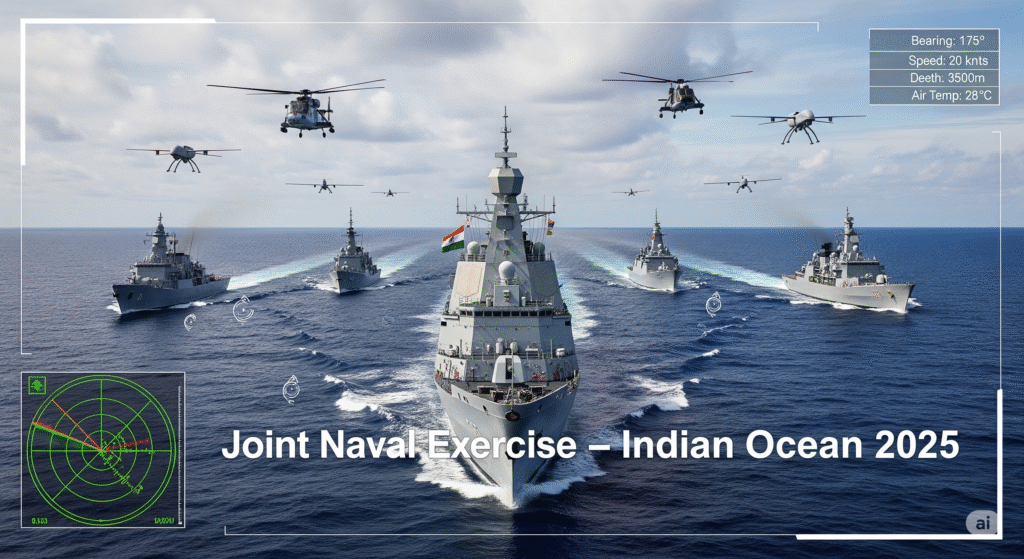Securing the Indo-Pacific: India’s Major Military Exercises & Strategic Drills in 2025
As maritime threats, grey-zone tactics, and technological advancements reshape the Indo-Pacific, India’s defence forces have doubled down in 2025—expanding the scale and sophistication of joint military exercises across air, sea, and cyber domains. These drills aren’t just showpieces—they’re essential for rapid deterrence, real-world readiness, and strategic partnerships with regional and global powers.
Introduction: New Challenges, New Responses
China’s naval expansion, drone swarms, and A2/AD systems are driving the need for more advanced joint drills. India’s focus in 2025 is clear: multi-domain coordination, interoperability with allies, and high-tempo scenarios that reflect hybrid warfare challenges. These efforts have moved far beyond traditional fleet reviews or limited air patrols.
The Year’s Key Joint-Service Exercises
- Exercise MILAN 2025 (Andaman & Nicobar Command): India led its largest-ever edition, bringing together 40 navies from the Indo-Pacific and Africa. Drills included anti-submarine warfare, UAV swarm defense, amphibious landings, cyber red-teaming, and quantum-encrypted comms. US, France, Japan, Australia, and Vietnam participated, deepening Quad and IOR “security mesh.”
- Air Force Red Flag (Alaska & Indian Sector): IAF participated with Su-30MKIs, Rafale, and IL-78 tankers, conducting high-altitude air combat and cross-continental refueling with USAF, RAF, and JASDF. New data sharing protocols trialed, prepping future “digital dogfight” environments.
- Tri-Services Exercise SINDHU GUARDIAN: For the first time, Army, Navy, Air Force, Indian Coast Guard, and newly operational Defence Space Agency conducted integrated beach defense and “kill web” networking for rapid, multidomain response. Included: simultaneous cyber-defense sweeps, drone swarm hunting, and missile interception drills.
- Varuna 2025 (India-France Naval Exercise): First deployment of Indian drones and autonomous ASW systems with French nuclear subs for “persistent zone denial” over 3,000 sq km. Used live AI-enabled threat mapping and simulated electronic warfare scenarios.
- Yudh Abhyas & Dharma Guardian (US/Japan with India): Expanded to new theatres in North-East and Bay of Bengal—emphasizing humanitarian assistance/disaster response (HADR), amphibious ops, and counter-UAV combat. Marked debut of Agniveer-trained teams and new Indian defence tech.
Strategic Impact and Deterrence
- Multi-Domain Synergy: India has moved from isolated drills to “fusion fighting”—where maritime, air, space, and cyber elements seamlessly connect via real-time networks, quantum crypto, and cloud-based C2.
- Deterrence Messaging: China’s exercises make these Indian-led drills critical—sending clear signals that India and partners can rapidly concentrate force, defend vital trade routes, and project power when required.
Technology Highlights: What’s New in 2025 Exercises
- Drone swarms (ideaForge, UNMANND) and anti-drone laser modules
- Quantum encrypted communications (QNu Labs prototypes)
- AI-enabled threat mapping (Tonbo Imaging, BBBS AR platforms)
- Live cyber red-teaming, simulating intrusion/defence in real time
Indo-Pacific Diplomacy: Partnerships and Soft Power
- Quad and Beyond: Unity with US, Japan, Australia, and France
- ASEAN, Africa, Gulf: Joint training, outreach, multilateral crisis response
Looking Ahead: Future Trends
- Integrated Theatre Commands: Multi-domain units, continually ready
- Space Operations: First joint-service “live” wargames in early 2026, satellite denial and rescue scenarios
For Defence Careers: New Roles & Training
- Cyber specialists, drone pilots, AI planners, space analysts, warfare instructors
- Agniveer alumni and tech officers placed in integrated commands, international exercise support
Conclusion: India’s Edge in 21st Century Military Readiness
2025 shows that India’s approach isn’t just reactive—it’s strategic, tech-driven, and partnership-focused. The new drills confirm India’s rapid evolution as a military innovator and a critical bulwark for Indo-Pacific peace and stability.



